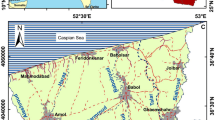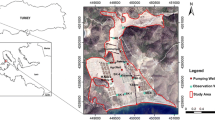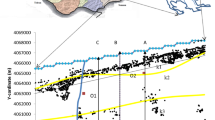Abstract
A physical model was proposed to describe the response of groundwater level in a coastal area to sea level variations. An impermeable interlayer is supposed to exist on the shore slope, simulating a layer of aufeis or frozen soil deepening into water and ending on the sloped bed at some depth under water. This interlayer hampers water exchange between the sea and the aquifer in the coastal zone. The results of this study were compared with those in similar studies with models containing no impermeable layer. New properties were revealed.


Similar content being viewed by others
REFERENCES
Fomin, Yu.V., Zhmur, V.V., and Marchenko, A.V., Transient seawater inflow into seacoast aquifers, Water Resour., 2017, vol. 44, no. 1, pp. 61–68.
Zhmur, V.V., Fomin, Yu.V., and Marchenko, A.V., Groundwater table formation in the coastal zone over a bed with arbitrary shape, Water Resour., 2018, vol. 45, no. 4, pp. 553–559.
Zyryanov, V.N., Zhmur, V.V., and Fomin, Yu.V., Nonlinear wave intrusion of water into coastal aquifers: theory, experiment, Sb. Tr. konf. “Vodnye resursy: Novye vyzovy i puti resheniya” (Trans. Conf. “Water Resources: New Challenges and Ways to Solution), Sochi, 2017, pp. 71–77.
Zyryanov, V.N., Frolov, A.P., and Khublaryan, M.G., Some nonlinear flow regimes of groundwater, Izv. Akad. Nauk, Ser. Mekh. Zhidk. Gaza, 2009, no. 5, p. 109.
Zyryanov, V.N. and Khublaryan, M.G., Pumping effect in the theory of nonlinear processes of the thermal conductivity equation type and its application in geophysics, Dokl. Earth Sci., 2006, vol. 408, no. 4, pp. 674–677.
Zyryanov, V.N., Khublaryan, M.G., and Frolov, A.P., Nonlinear dynamics of gravity filtration of ground waters, Dokl. Earth Sci., 2009, vol. 426, no. 1, pp. 591–595.
Polubarinova-Kochina, P.Ya., Teoriya dvizheniya gruntovykh vod (Theory of Groundwater Flow), Moscow: Nauka, 1977.
Fomin, Yu.V., Nonlinear effects of seawater wave intrusion into coastal aquifers in a tidal sea, Cand. Sci. (Phys.-Math.) Dissertation, Moscow: Water Problems Institute, Russian Academy of Sciences, 2017.
Fomin, Yu.V., Nature of pumping-effect in the coastal zone, Tr. Gidrometts. Ross., 2016, no. 361, pp. 203–230.
Bear, J., Dynamics of Fluids in Porous Media, New York: Elsevier, 1988.
Jeng, D.-S., Seymour, B.R., Barry, D.A., Li, L., and Parlange, J.-Y., New approximation for free surface flow of groundwater: capillarity correction, Adv. Water Resour., 2005, vol. 28, pp. 1032–1039.
Funding
The study was carried out under State Assignment no. 0149-2019-0004.
Author information
Authors and Affiliations
Corresponding author
Additional information
Translated by G. Krichevets
APPENDIX 1
APPENDIX 1
The Condition of Weak Difference between the Local Horizontal Flow Velocity \(u\left( {x,y} \right)\) and the Velocity \(\bar {u}\left( x \right)~\) Averaged across the Flow
The boundary condition (11) was derived using the small difference between the local horizontal flow velocity \(u\left( {x,y} \right)\) and the mean horizontal velocity across the flow \({\mathbf{\bar {u}}}\left( x \right)~\) in the domain of the water-bearing layer under frozen soil, where groundwater has no free surface. In Fig. 1, this domain is denoted as a curvilinear trapezoid \(ABCD.\) This limitation will no doubt be met under the shallow-water approximation. Note that Boussinesq equation, which holds in the domain of the aquifer where there is a free surface, has also been derived under shallow-water approximation. The idea to use the coarse boundary condition (11) is due to the fact that the Boussinesq equation itself has also been written with the same level of approximation. In this case, the use of a more accurate boundary condition along with the coarse Boussinesq equation will not improve the general accuracy of problem solution. The linearization of Boussinesq equation (the replacement of the nonlinear equation (6) by the linear equation (23)) makes the solution of the problem even more inaccurate. Therefore, the approximate boundary condition is enough for farther reasoning; in this case, the local horizontal flow velocity \(u\left( {x,y} \right)\) can be replaced by the mean horizontal velocity \({\mathbf{\bar {u}}}\left( x \right)\) over the local flow thickness. Now we evaluate the error at such change. To make the problem simpler, we assume that the upper boundary of domain \(ABCD\) is flat, i.e., the upper boundary BC of the trapezoid ABCD is a straight line. We also suppose that the flow in the domain \(ABCD\) is similar to the flow from a point source placed at the vertex of the angle \(\angle O\) , i.e., the intersection of the extensions of segments \(AD\) and \(BC\). This will be true if segment \(AB\) is small compared with segment \(CD,\) or, equivalently, points \(A\), \(B\), and \(O\) practically coincide. In that case, the flow will radially diverge from point O and attenuate as \(\frac{1}{r}\) (\(r\) is the distance from point \(~O\) to the point under consideration). We denote the radial velocity by \({{u}_{r}}\), we have \({{u}_{r}} = \frac{q}{r}\) (\(q\) is some variable related to the flow from source in point \(O\), \(q\) may be time-dependent).
We introduce in domain \(ABCD\) polar coordinates \(\left( {r,{{\varphi }}} \right),~{{\varphi }}\) is the angle between the radius-vector \(\vec {r}\) and segment \(OD\). For brevity, we denote the length of segment \(OD\) by \(R\). Consider the horizontal component of velocity in segment \(CD\). We choose in \(CD\) an arbitrary point M with polar coordinates \(\left( {r,{{\varphi }}} \right)\). In the proposed denotations, \(r = \frac{R}{{{{\cos\varphi }}}}\), the radial velocity in point M is \({{u}_{r}} = \frac{q}{R}{{\cos\varphi }}\), and the horizontal velocity component is \(u = \frac{q}{R}{\text{co}}{{{\text{s}}}^{2}}{{\varphi }}~\). In segment CD, the horizontal component of velocity will decrease as point M moves upward because the angle \({{\varphi }}~\) decreases in the range \(0 < {{\varphi }} < {{\alpha }}\). Here \({{\alpha }}\) is the slope of segment BC with respect to horizon. The mean value of the horizontal component of velocity u in segment CD is equal to the value \(~u = \frac{q}{R}\left( {1 - \frac{{{\text{si}}{{{\text{n}}}^{2}}{{\alpha }}}}{3}} \right)\). Now we return to the problem of replacement of the local horizontal flow velocity in domain ABCD by its mean value over the given vertical segment. The local horizontal velocity is taken equal to \(u = \frac{q}{R}{\text{co}}{{{\text{s}}}^{2}}{{\varphi }}\), and the mean horizontal flow velocity at the vertical CD is \(~u = \frac{q}{R}\left( {1 - \frac{{{\text{si}}{{{\text{n}}}^{2}}{{\alpha }}}}{3}} \right)\). The maximal possible difference between the velocities \(\bar {\mathbf{u}}\) and \(~u\) corresponds to the velocity value u in point \(D\) at \({{\varphi }} = 0\). Now, the maximal possible error at the replacement of \(\bar {u}\) by \(\left\langle {~u} \right\rangle \) will be \({{\delta }}u = {\mathbf{\bar {u}}} - u = \frac{q}{R}\frac{{{\text{si}}{{{\text{n}}}^{2}}\alpha }}{3}\), and the maximal relative value will be \(\frac{{{{\delta }}u}}{{~u}} = \frac{{{\text{si}}{{{\text{n}}}^{2}}{{\alpha }}}}{3}\). As can be seen, the replacement of \(u\) by \(\left\langle {~u} \right\rangle \) is admissible for small \({{\alpha }}\) and inadmissible for large \({{\alpha }}\). Let us consider the numerical values of \(\frac{{{{\delta }}u}}{{~\bar {\mathbf{u}}}}\) for different values of α (Table 3).
We return to Boussinesq equation and evaluate the relative error due to linearization of equations. This can be easily done to yield the value of the order of \(\frac{a}{H}\). For the case of the polygon at Spitsbergen Isl., we have \(\frac{a}{H} = 0.17\). Therefore, if we assume that the error of 0.17 is acceptable in the main equation, then, in order not to exceed the accuracy in the other part of the problem (in the boundary condition), we have to accept that the slope of the lower surface of the frozen soil with respect to horizon, equal to \(45^\circ \), is quite acceptable, but it must not exceed this value. We remind that the shore slope in Lake Spitsbergen test ground is 7°, which allows the boundary conditions (11) to be valid with a relative error <0.01. The boundary equation in that case is less accurate than the boundary condition.
APPENDIX 2
Natural Restriction of Problem Parameters
The problem was solved under the assumption that both edges, either for seawater or for groundwater, are gliding along the boundaries of the impermeable layer on different sides and never drop below the deepest part of the impermeable layer, i.e., the underwater edge of ice or frozen soil, \(y = {{h}_{0}} < 0\). This implies the validity of the inequality
It is assumed that all results obtained in this study satisfy the inequality (2.1). As can be seen, these results are fundamentally inapplicable to the case when \({{h}_{0}} \geqslant 0\).
When the inequality (2.1) is not true, seawater edge in the upper part glides over the boundary of the impermeable layer, and, in the lower part, it extends to porous shore soil. The behavior of groundwater edge in this case is still not clear. A question also arises: what boundary conditions are to be imposed on the levels of seawater and groundwater at their contact in this more general case. All the problems mentioned here will be studied and developed in the future.
Rights and permissions
About this article
Cite this article
Zhmur, V.V., Fomin, Y.V. Transient Seepage of Seawater in the Coastal Zone under Freezing of This Zone. Water Resour 49, 201–211 (2022). https://doi.org/10.1134/S0097807822020166
Received:
Revised:
Accepted:
Published:
Issue Date:
DOI: https://doi.org/10.1134/S0097807822020166




